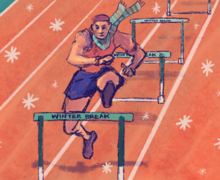James Williams looks to be the next SU punter to play in NFL
Courtesy of Anthony Giugliano
After two clean punts in his first career start against Ohio, Williams played a larger role against Rutgers as SU’s offense struggled in a 17-7 loss.
Get the latest Syracuse news delivered right to your inbox.
Subscribe to our sports newsletter here.
Early in the second quarter against Rutgers, freshman James Williams’ heels hugged the back of the end zone. After an illegal formation penalty, Syracuse was pushed back to the 4-yard line.
The Scarlet Knights had already blocked one punt earlier in the game, but Williams wasn’t rattled. He handled the clean snap, dropped it and launched the ball 60 yards down the field. It landed a few yards across SU’s 40-yard line but bounced in the air and rolled down the sideline before settling at Rutgers’ 36-yard line. RU’s ensuing three plays moved the ball backwards, and the game remained scoreless heading into halftime.
After two clean punts in his first career start against Ohio, Williams played a larger role against Rutgers as SU’s offense struggled in a 17-7 loss. Williams punted six times for an average of over 40 yards, including the 60-yard kick.
But Syracuse’s special teams unit as a whole struggled in the loss. In addition to the blocked punt, kicker Andre Szmyt missed his only field goal attempt, punt returner Trebor Pena misplayed multiple punt returns, and SU recorded three illegal formation penalties while punting. Williams was briefly replaced by backup Colby Barker, but Barker’s only punt traveled just eight yards.
“There were numerous mistakes in the kicking game,” head coach Dino Babers said postgame. “I thought the kicking game cost us as much as the offense not scoring many points.”
Williams is Syracuse’s next punter in line, following former Syracuse punters Riley Dixon, Sterling Hofrichter and Nolan Cooney — all of whom signed with NFL teams after graduating from SU. Dixon is in his sixth year as a starting punter in the NFL, and Hofrichter appeared in 16 games with the Atlanta Falcons last year. Cooney was waived by the New Orleans Saints, but he received third-team All-Atlantic Coast Conference honors after one season as the Orange’s starting punter. But more importantly, he helped mentor Williams last season.

Megan Thompson | Design Editor
“Obviously I’m my own person,” Williams said. “It feels good to have people and know the standard of what to expect at practice and how to handle things like that to the point where I could be in the NFL.”
Dixon became the second former SU punter to be taken in the NFL draft. He arrived at Syracuse in 2011, the year after four-year starter Rob Long graduated. Long mentored Dixon when he was in graduate school at SU during Dixon’s early years as starting punter.
Dixon was two inches taller and nearly 30 pounds heavier than Long, but Long said Dixon needed confidence to live up to his potential — something Long was able to provide. By his senior year, Dixon was a semifinalist for the Ray Guy Award — given to the nation’s top punter — and was taken in the NFL draft the following spring.
In 2015, Dixon’s successor, Hofrichter, studied under him. Hofrichter said when he arrived at SU, he was always trying to “kill” the football and punt as far as possible. But Dixon told Hofrichter to instead focus on being smooth and hitting a clean punt. The following year, Hofrichter was a freshman All-American. As he went through his collegiate career, Hofrichter worked on the direction and hang time of his punts. By 2019, he was a first-team All-American and the second straight Syracuse punter to be selected in the NFL draft.
Cooney followed Hofrichter as the starting punter after four years sitting behind him. Cooney helped Hofrichter throughout his career, serving as “another set of eyes” for Hofrichter from the sidelines, Hofrichter said. He told Hofrichter when he looked too quick on his punts or if his hands were too twitchy catching snaps.
When given a chance to start in 2020, Cooney averaged 44.8 yard per punt, the highest single-season average in program history. After going undrafted, Cooney signed with the New Orleans Saints, becoming the third straight SU punter to sign with an NFL team.
“There’s a bar that is set by the guy prior to you,” Long said. “I know Riley wanted to beat what I had done and Nolan, and Sterling after Riley. I think it’s just that competitive fury that we’ve all had.”
When he committed to SU in June 2019, Williams was ranked one of the top 10 kickers in the country by Rivals and ESPN. Like the punters before him, Williams studied under his predecessor. Both Williams and Cooney do punts and kickoffs, and Williams said Cooney taught him how to correctly handle the speed of a Division I game.
In high school, Williams punted and kicked for Athens Academy (Georgia). He came into his freshman year handling outside linebacker, wide receiver and special teams duties, but he stuck to just punting and kicking once he arrived at Athens.

Maya Goosmann | Digital Design Director
In his freshman year, Williams only did kickoffs and long-range field goals while sitting behind Drew Byus, who later walked on as a kicker at Georgia. Williams and Byus worked on kicking direction and performing under pressure during their one year together, Athens assistant Ken Whitehead said. Throughout his high school years, Williams learned how to rest his leg and be more accurate with the placement of his kicks, Whitehead said.
“He had the boom. He had the leg. He just had to learn how to control it and how to put the ball where he wanted,” Whitehead said.
Williams also attended camps with Kohl’s Kicking, where he worked with regional instructor Anthony Giugliano. When Giugliano first saw Williams, he was impressed by the punter’s frame, along with his flexibility — something he considers “rare” for a player with Williams’ stature. He compared Williams to Dixon, noting their build, hands and dropping skills are similar.
Giugliano taught Williams to concentrate by doing instead of overthinking, he said. The two worked on hand-eye coordination and being quick with hand and drop movements on punts. Punters need to work on being able to drop the ball toward their foot the same every single time, Giugliano said. Once Williams’ drops were more consistent, the two started working on ball-foot contact.
“I would say he’s done more drops in the last year to year-and-a-half than he’s probably done his whole life,” Giugliano said. “That translates over to consistent hits the majority of the time … So a lot of work goes into (that) for him and for every punter, is how they attack the ball, how they catch it, how they hold it, how they drop it.”
Williams’ high number of reps increased his execution and consistency on punts since his sophomore year at Athens, Giugliano said. By his senior year, Williams gave Athens four to five touchbacks per game and could pin opposing teams inside their own 20-yard line whenever asked, Whitehead said.
In one game against Stephens County (Georgia) High School in 2019, Williams had so much hang time on his punt that the punt returner got nervous, Whitehead said, muffing the ball. Athens recovered it inside the 20-yard line. The Spartans won the game 49-19 and went 11-1 that season, making an appearance in the state championship for the second straight year.

Maya Goosmann | Digital Design Director
When Williams made his first start at Syracuse in week one against Ohio, Babers said his punter was entering a “spooky” situation as a freshman specialist on the road. Williams dropped two punts inside the 20-yard line in that game, but against Rutgers, Williams and the rest of the special teams unit showed its inexperience, Babers said.
“When you’re back there and you’re in front of those crowds, you need freshmen to grow up in those situations. Everybody’s going to have their first kick. Everybody’s going to have their first kick blocked as a freshman,” Babers said. “They grow up, they get better.”
Williams and Babers both denied that SU’s lack of a specific special teams coordinator has hurt them so far this season. Syracuse’s previous special teams coordinator, Justin Lustig, left for an assistant job at Vanderbilt after last season. Lustig helped coach Hofrichter and Cooney, as well as Szmyt — who was given the Lou Groza Award for the country’s top kicker in 2018. Babers chose not to fill the coordinator vacancy, instead choosing to share the responsibility among multiple assistants on his staff, he said.
Now, Williams and the rest of the special teams group practice day-to-day with other assistants like Blair Cavanaugh. The group starts with field goals — which Williams usually doesn’t participate in — before moving into kickoffs and punts. The unit then has the rest of practice off, and they usually leave the field to work on other drills away from the rest of the team, Williams said.
Coming off their first loss of the season, Williams and the Orange have 10 games remaining, starting Saturday against UAlbany. While Williams and others may have appeared slightly rattled against Rutgers, Giugliano said Williams’ overall consistency as a punter will show as Syracuse’s next punter in line, following in the footsteps of Dixon and Hofrichter.
“It doesn’t matter if he’s playing an FCS school for the first game at the Dome in Syracuse or if he’s punting backed up in the end zone in Death Valley at Clemson,” Giugliano said, “he’s going to hit the same ball every time.”
Published on September 15, 2021 at 9:33 pm
Contact Connor: csmith49@syr.edu | @csmith17_






